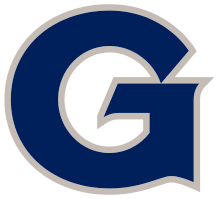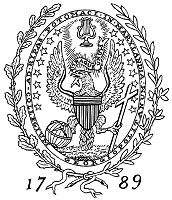Georgetown Hoyas football
| Georgetown Hoyas | |||
|---|---|---|---|
| |||
 | |||
| First season | 1874 | ||
| Athletic director | Lee Reed | ||
| Head coach |
Rob Sgarlata 3rd year, 10–18 (.357) | ||
| Stadium | Cooper Field | ||
| Seating capacity | 2,500 | ||
| Field surface | FieldTurf | ||
| Location | Washington, D.C. | ||
| NCAA division | Division I FCS | ||
| Conference | Patriot League | ||
| Past conferences |
MAAC (1993–1999) SAIAA (1907–1921) | ||
| All-time record | 506–416–32 (.547) | ||
| Bowl record | 0–2 (.000) | ||
| Conference titles | 2 | ||
| Consensus All-Americans | 18 | ||
| Colors |
Blue and Gray[1] | ||
| Fight song | There Goes Old Georgetown | ||
| Mascot | Jack the Bulldog | ||
| Rivals | Howard Bison | ||
| Website | www.guhoyas.com/football | ||
The Georgetown Hoyas football team represents Georgetown University in the Division I Football Championship Subdivision level of college football. Like other sports teams from Georgetown, the team is named the Hoyas, which derives from the chant, Hoya Saxa. They play their home games at Cooper Field on the Georgetown University campus in Washington, D.C.
History
 Georgetown versus Quantico Marines in 1923 |
The first football team at Georgetown was formed on November 1, 1874, with the earliest recorded intercollegiate games dating to 1887.[2] By the 1940s, Georgetown played in the Orange Bowl, where they lost 14–7 to Mississippi State.
As the college game became more expensive after World War II, Georgetown's program began to lose money rapidly.[3] The Hoyas' last successful season was 1949, when they lost in the Sun Bowl against Texas Western.[3]
After a 2–7 season in 1950, Georgetown attempted to salvage its program by softening its schedule, replacing major opponents such as Penn State, Miami, and Tulsa with Richmond, Bucknell, and Lehigh.[3] The program was losing too much money, however, and on March 22, 1951 the University's president canceled the football program.[3][4]
In 1962, Georgetown allowed its students to start a football program as an exhibition-only club sport. New games began in 1964, with their first match drawing 8,000 spectators to see the Hoyas host another university with an unofficial program, New York University (NYU).[5] Varsity football resumed in 1970 at what later became known as the Division III level.[6] In 1976, Georgetown began an annual rivalry game with the Catholic University Cardinals for the Steven Dean Memorial Trophy. The competition ended in 1993, when Georgetown moved into the Division I Football Championship Subdivision because of NCAA legislation forbidding Division I or II schools from playing football in lower divisions.
In 1993, the team joined the Metro Atlantic Athletic Conference, a mostly Catholic conference on the East Coast. With eight wins, the team won the conference championship outright in 1997, and were co-champions in 1998 with nine wins. The team was invited to play in the 1997 Sports Network Cup, where they defeated the Dayton Flyers. In 1999 the team joined the Patriot League, a conference that currently prohibits its members from awarding football scholarships.[7] As a non-scholarship FCS program, many of Georgetown's non-conference games are against Ivy League schools, which do not award scholarships for any sport. Without the ability to add scholarships, Georgetown's program fell on hard times in the 2000s. Georgetown had by far the lowest football budget in the Patriot League, at less than half that of the next highest program. Georgetown also had the lowest number of Patriot League FSE's (funded scholarship equivalences) which measures the financial aid given out to its Varsity football players.
During its first decade in the Patriot League, the team was unable to have a single winning season, and the 2009 campaign yielded no wins.[7] However, the Hoyas' 2011 Football team finished with a strong 8–3 record and second place in the Patriot League, becoming the first Hoya squad to produce a winning record in twelve seasons, and head coach Kevin Kelly was named the conference Coach of the Year.[8]
Classifications
- 1937–1950: NCAA University Division
- 1951–1963: No team
- 1964–1972: NCAA College Division
- 1973–1992: NCAA Division III
- 1993–present: NCAA Division I–AA/FCS
Conference memberships
- 1887–1906: Independent
- 1907–1921: South Atlantic Intercollegiate Athletic Association
- 1922–1950: Independent
- 1951–1963: No team
- 1964–1972: Independent
- 1973–1992: Division III Independent
- 1993–1999: Metro Atlantic Athletic Conference
- 2000: Division I–AA Independent
- 2001–present: Patriot League
Stadiums

Georgetown has played football at various on-campus intramural fields. From 1891 until 1893, the stadium known as Boundary Field played host to Georgetown football. From 1921 until 1950, Griffith Stadium played host to Georgetown football.
Currently, the Hoyas play at Cooper Field, previously called Multi-Sport Field, which was upgraded from Harbin Field in 2003. The MSF has been awaiting further construction since 2005, when work was halted on completing permanent bleachers and other facilities. As a result, it remains the smallest stadium in Division I football and has only temporary bleachers as a part of the current set-up. The construction plans remain on hold indefinitely until the administration can properly fund the completion of the project.
D.C. Cup Rivalry Game
The Hoyas have a new cross-town rivalry with Howard University (which also plays at the FCS level, but awards football scholarships), for a championship known as the DC Cup (awarded by the mayor of Washington). Three DC Cups have been held (2008, 2009 and 2011).[9] The series has Georgetown leading 2–1–0 following their 2011 victory.
Conference championships
Georgetown has won two conference championships.
| Year | Coach | Conference | Record |
|---|---|---|---|
| 1997 | Bob Benson | Metro Atlantic Athletic Conference | 8–3 (7–0), outright champions |
| 1998 | Bob Benson | Metro Atlantic Athletic Conference | 9–2 (6–1), co-champions |
Bowl Games
While in the Major College Division of the NCAA (what is now the FBS), Georgetown competed in two major bowl games (including a New Year's Day bowl game), one of which is today a BCS Bowl Game.
| Bowl | Date | Opponent | Result |
|---|---|---|---|
| Orange Bowl | January 1, 1941 | Mississippi State | L 7–14 |
| Sun Bowl | January 1, 1950 | UTEP | L 20–33 |
Polling
Georgetown was ranked in the AP Poll while a member of the Major College Division.
| Season | Poll(s) | Rank |
|---|---|---|
| 1940 | AP Poll | 13 |
Alumni
Perhaps the football team's most accomplished athlete was Al Blozis, who would play for the NFL's New York Giants before being killed in action in World War II. Blozis's great athletic accomplishments, however, came in shotput and discus. He set the world indoor record for the shotput, throwing it 56 feet 4.5 inches in 1941. He was the national indoor and outdoor shotput champion in both 1942 and 1943.[10]
"Big Jim" Ricca, an NFL defensive end and offensive lineman, graduated in 1949 and was the last Hoya to play in an NFL game.[10]
Jim Schwartz, former head coach of the NFL's Detroit Lions, was a four-year letterman at linebacker. He received Distinguished Economics Graduate honors and earned numerous honors in 1988, including Division III CoSIDA/GTE Academic All-America, All-America, and team captain.
In 2007, the Washington Redskins made Alex Buzbee a reserve player, becoming the first Georgetown player on an NFL team since Ricca retired in 1956.[11] In 2010, Buzbee joined the Toronto Argonauts of the Canadian Football League.
Key
| B | Back | K | Kicker | NT | Nose tackle |
| C | Center | LB | Linebacker | FB | Fullback |
| DB | Defensive back | P | Punter | HB | Halfback |
| DE | Defensive end | QB | Quarterback | WR | Wide receiver |
| DT | Defensive tackle | RB | Running back | G | Guard |
| E | End | T | Offensive tackle | TE | Tight end |
| Year | Round | Pick in round | Overall pick | Player | Team | Position |
|---|---|---|---|---|---|---|
| 1953 | 11 | 5 | 126 | Jim Slowey | Bears | C |
| 1951 | 10 | 4 | 114 | Bob Noppinger | Packers | T |
| 1951 | 11 | 10 | 133 | Tom Hardiman | Bears | B |
| 1950 | 30 | 5 | 383 | Bob Noppinger | Redskins | E |
| 1950 | 30 | 7 | 385 | Vick Banonis | Cardinals | C |
| 1945 | 16 | 4 | 157 | Mike Costello | Yanks | E |
| 1945 | 19 | 4 | 190 | Joe Drumm | Yanks | T |
| 1945 | 28 | 4 | 289 | John Morelli (American football) | Yanks | G |
| 1945 | 30 | 4 | 311 | Elmer Oberto | Yanks | G |
| 1944 | 13 | 8 | 128 | Bill Duffey | Bears | E |
| 1943 | 11 | 10 | 100 | George Perpich | Redskins | T |
| 1943 | 13 | 2 | 112 | Bill Erickson | Eagles | C |
| 1943 | 17 | 10 | 160 | Frank Dornfield | Redskins | B |
| 1943 | 22 | 10 | 210 | Johhny Barrett | Redskins | B |
| 1943 | 30 | 2 | 282 | Stan Jaworowski | Eagles | T |
| 1942 | 5 | 8 | 38 | Al Blozis | Giants | T |
| 1942 | 10 | 8 | 88 | Mike Kopcik | Giants | E |
| 1941 | 4 | 5 | 30 | Augie Lio | Lions | G |
| 1941 | 8 | 8 | 68 | Al Matuza | Bears | C |
| 1941 | 18 | 1 | 161 | Joe McFadden (American football) | Eagles | B |
| 1941 | 19 | 10 | 180 | Earl Fullilove | Redskins | T |
| 1941 | 21 | 3 | 193 | Jules Koshlap | Dodgers | B |
| 1941 | 21 | 2 | 202 | Jim Castiglia | Steelers | B |
| 1936 | 9 | 3 | 75 | Joe Meglen | Steelers | B[12] |
References
- ↑ "Primary and Secondary Colors". Retrieved 2016-04-10.
- ↑ "Football's Roots At Georgetown". HoyaSaxa.com. August 17, 2005. Retrieved February 12, 2010. External link in
|work=(help) - 1 2 3 4 "Georgetown Football History Chapter 7: The End Of One Era...". HoyaSaxa.com. August 17, 2005. Retrieved November 25, 2009.
- ↑ "Intercollegiate Football Ends at Georgetown". Chicago Daily Tribune. March 23, 1951. p. B2.
- ↑ "Georgetown Returns to Football And Crushes N.Y.U. Club, 28–6". The New York Times. November 22, 1964. p. S6.
- ↑ "Georgetown Football History Chapter 9: The Return To Division I". HoyaSaxa.com. August 17, 2005. Retrieved November 25, 2009.
- 1 2 El-Bashir, Tarik (November 3, 2011). "Georgetown football hopes to complete astounding turnaround, win Patriot League". The Washington Post. Retrieved November 28, 2011.
- ↑ Shine, Tim (November 23, 2011). "Georgetown football receives Patriot League honors". The Georgetown Voice. Retrieved November 28, 2011.
- ↑ "Howard 14, Georgetown, D.C. 11 – NCAA Football – CBSSports.com Live GameCenter". September 26, 2009. Retrieved October 1, 2009.
- 1 2 "Glory Days: The Past, Present and Future of Hoyas Turned Professional Athletes". The Hoya. January 23, 2004. Archived from the original on October 24, 2007. Retrieved December 18, 2009.
- ↑ Carrera, Katie (August 8, 2007). "For Redskins Rookie, Slogan Is Hoya Sacks". The Washington Post. Retrieved July 21, 2008.
- ↑ DraftHistory.com
External links
| Wikimedia Commons has media related to Georgetown Hoyas football. |
